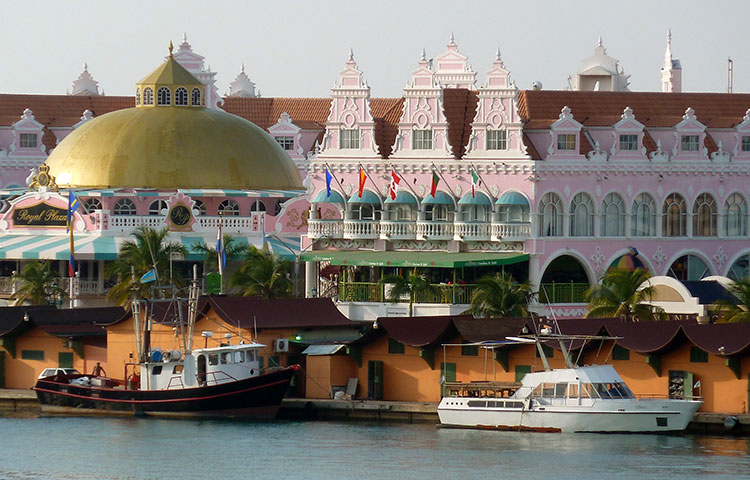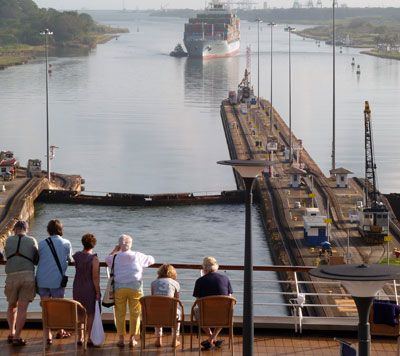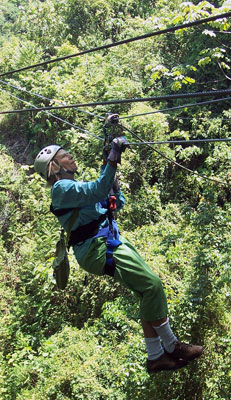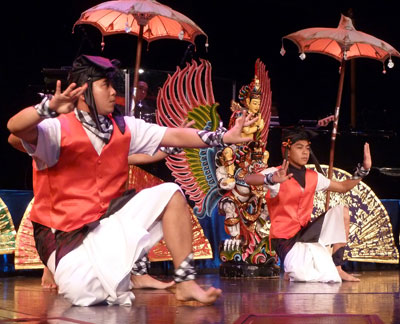Cruising through the Panama Canal
This article appears on page 44 of the October 2013 issue.
Bill Murphy, 91, looked out on the blinking crimson lights of the channel markers as the ms Amsterdam passed the skeletal-like cranes that pierced the opalescent dawn.
“I’ve been on 23 cruises, but this is the one I always wanted to make — going the 48 miles through the Panama Canal,” Murphy said as a dolphin cut the surface off the port bow.
The loudspeaker of the Holland America Line (HAL) cruise ship boomed, “It’s the 50th transit of the canal for the Amsterdam.”
My wife, Kathy, and I looked up at Deck 6 lined with sleepy, camera-toting passengers looking down at a channel dug in 1904. (The present canal’s expansion, begun in 2007, is set to be complete in 2014.)
Three pilot boats shepherded us through one of history’s most remarkable engineering feats. The canal shortens the distance between many Atlantic and Pacific ports by 8,000 miles and cuts the mileage from Great Britain to New Zealand by 1,500 miles.
The canal was alluring as the Amsterdam made its way, entering the Gatun Locks at 7 a.m., crossing Gatun Lake, going through the Culebra Cut, then the Pedro Miguel Locks and the Miraflores Locks and passing the distant towering buildings of Panama City before entering Panama Bay and the swells of the Pacific Ocean at day’s end.
Life on board
Kathy and I opted for HAL’s 15-day Panama Canal cruise ($1,999 per person, double occupancy, for an ocean-view cabin) because we wanted to experience the canal aboard a ship.
We left Fort Lauderdale, Florida, on May 1, 2013, spending eight days at sea and making stops at Aruba; Puerto Caldera, Costa Rica; Corinto, Nicaragua, and Santa Cruz Huatulco, Puerto Vallarta and Cabo San Lucas, Mexico, before disembarking in San Diego, California, on May 15. The ship continued on, ending in Vancouver, Canada.
This trip offered a great price, royal pampering, fabulous food and time to enjoy the sea, relax, read, swim in the pool and partake in some of the 500 activities offered. From an earlier Holland America cruise, we knew the line lived up to its promise of “classic cruising” and “gracious service.” We also knew of its high returning-customer rate.
Sailing from Fort Lauderdale in fog and rain, we explored the ship’s excellent library, gym, restaurants, pools and comfortable theater. Although 1,380 passengers and 647 crew were aboard, it never seemed crowded.
Our spacious, ocean-view cabin had a large, comfortable bed, a large closet with removable hangers, a table, a desk, a flat-screen TV (one channel gave our position, course and sea position) and a couch. In the evenings, we often sipped wine on the lower promenade deck outside our cabin and enjoyed the seascape.
The Amsterdam has 10 decks, 12 guest elevators, 16 public rooms and automatic stabilizers. We never felt the waves.
An Explorer newsletter, put outside our cabin each morning, offered a news summary, informed us of activities on board, profiled crew members, lecturers, entertainers and the line’s history and introduced the next port of call. It gave times and locations for everything, from culinary classes to the complimentary computer classes. Daily, free classes concerning body, mind and spirit were also offered.
Breakfast on the Lido deck was bountiful, with seven types of eggs Benedict. Seven?! As an amateur in this field, I led off the first morning conservatively, with classic eggs Benedict. I moved on daily — Florentine eggs Benedict, St. George eggs Benedict, Italian eggs Benedict, Stanley eggs Benedict (with seafood), Scottish eggs Benedict and a barbecued eggs Benedict whose actual title escapes me. All were delicious.
The Lido was introduced as a less formal dining experience, along with the terrace grill at the pool, where we often enjoyed breakfast.
For me, the sea was endlessly fascinating with its infinite shades of blues, dancing white wakes and underwater swirls of turquoise. I photographed its ever-changing moods.
Another joy was photographing crew members, who were always ready to pose.
Going ashore
Our first stop after leaving Fort Lauderdale was Oranjestad, the historical Dutch capital of the island of Aruba. The picturesque town was a bargain hunter’s paradise, featuring sophisticated luxury malls with prestigious international brands such as Louis Vuitton, Gucci, Rolex and Cartier in the duty-free shops. However, with our guide Ricardo, we instead set off to catch a taste of this island’s turquoise waters, azure skies, alabaster beaches and diverse topography.
One coast offered calm waters and long stretches of sparkling white beaches, while the craggy, windswept north coast was riddled with pebble beaches, secluded coves and soaring, rocky arches creating natural bridges.
Inland, a hilly, dusky desert was dotted with tall, thorny cacti and dusty brush punctuated by mysterious quartz diorite rock formations and even a few scattered peaks.
Kathy was up early at Puerto Caldera, Costa Rica, anxious to take her 10-mile-long zipline tour through the canopy of a rainforest and relax aboard a tram tour ($140).
Exploring the canopy of this traditional rainforest in Costa Rica’s mid-Pacific coastline is best accomplished by riding the Pacific rainforest aerial tram.
They glided silently from the floor to the treetops on this modified ski lift. For 30 minutes, the guide spoke reverently of the wildlife, the medicinal value of plants and the helicopter-assisted building process aimed at preserving this unique ecosystem.
At the end of the tram ride, they were high enough to begin the zipline trip down the hillside, after suiting up with the harness and hooks.
As Kathy stepped into her harnesses, the guide said, “We are about to conquer all our fears. Get ready to cry, scream and pray.”
For my wife, the highlights were “seeing the Pacific Ocean from such a prominent viewpoint as well as the freedom of flying above the beautiful tropical rainforest.”
A few last stops
Sleepy Corinto, Nicaragua, sits on a barrier island and is an important Pacific access point to the country’s rugged interior. Nicaragua has the largest area of primary-growth rainforest north of the Amazon; hundreds of soft, white-sand beaches; six active volcanoes, and plenty of sleepy surf towns.
Guide Roberto Rodriguez charged us $10 for an hour-long tour of Corinto on his 2-seat tricycle topped with a square canopy. It was perfect for exploring the side streets, and a main-street lane was set aside for carts.
We stopped to chat with his English teacher’s class, popped in on barber shops and watched a tailor working his sewing machine on the street as children looked on. Slowly, our Spanish returned.
Puerto Vallarta, Mexico’s most popular Pacific resort, was spread out before us as we anchored in the big, blue Bahía de Banderas. Behind rose tropical mountains, beaches, white buildings with red-tile roofs and the cathedral surrounded by cobblestone streets. We took a cab to the Old Town, visiting the cathedral and strolling the promenade with its artistic stone statues, paintings and pleasant atmosphere.
In the winter months, humpback whales come into the bay, drawing whale-watchers worldwide.
When we disembarked at San Diego, some 40 ’round-the-world voyagers were still aboard. Maybe someday we’ll join them.




